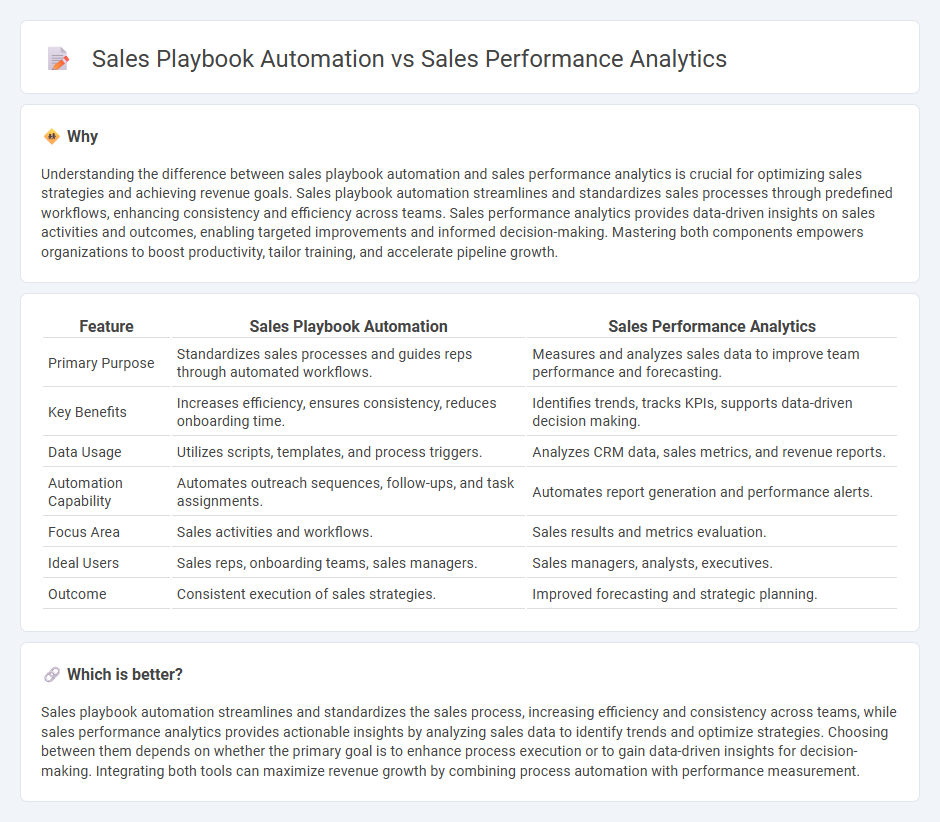
Sales playbook automation streamlines repetitive tasks, enabling sales teams to follow proven strategies efficiently and improve consistency in customer interactions. Sales performance analytics provides data-driven insights by measuring key metrics such as win rates, conversion rates, and sales cycle length to identify strengths and gaps in the sales process. Explore how integrating both tools can optimize your sales operations for better results.
Why it is important
Understanding the difference between sales playbook automation and sales performance analytics is crucial for optimizing sales strategies and achieving revenue goals. Sales playbook automation streamlines and standardizes sales processes through predefined workflows, enhancing consistency and efficiency across teams. Sales performance analytics provides data-driven insights on sales activities and outcomes, enabling targeted improvements and informed decision-making. Mastering both components empowers organizations to boost productivity, tailor training, and accelerate pipeline growth.
Comparison Table
| Feature | Sales Playbook Automation | Sales Performance Analytics |
|---|---|---|
| Primary Purpose | Standardizes sales processes and guides reps through automated workflows. | Measures and analyzes sales data to improve team performance and forecasting. |
| Key Benefits | Increases efficiency, ensures consistency, reduces onboarding time. | Identifies trends, tracks KPIs, supports data-driven decision making. |
| Data Usage | Utilizes scripts, templates, and process triggers. | Analyzes CRM data, sales metrics, and revenue reports. |
| Automation Capability | Automates outreach sequences, follow-ups, and task assignments. | Automates report generation and performance alerts. |
| Focus Area | Sales activities and workflows. | Sales results and metrics evaluation. |
| Ideal Users | Sales reps, onboarding teams, sales managers. | Sales managers, analysts, executives. |
| Outcome | Consistent execution of sales strategies. | Improved forecasting and strategic planning. |
Which is better?
Sales playbook automation streamlines and standardizes the sales process, increasing efficiency and consistency across teams, while sales performance analytics provides actionable insights by analyzing sales data to identify trends and optimize strategies. Choosing between them depends on whether the primary goal is to enhance process execution or to gain data-driven insights for decision-making. Integrating both tools can maximize revenue growth by combining process automation with performance measurement.
Connection
Sales playbook automation streamlines the implementation of standardized sales strategies, ensuring consistent execution across teams while capturing critical performance data. Sales performance analytics leverages this data to identify trends, measure key performance indicators (KPIs), and optimize sales processes in real-time. The integration of automated playbooks with analytics enables predictive insights that enhance forecasting accuracy and drive revenue growth.
Key Terms
**Sales Performance Analytics:**
Sales Performance Analytics leverages data-driven insights and key metrics such as conversion rates, average deal size, and sales cycle length to evaluate and improve team effectiveness. By analyzing historical sales data, companies can identify trends, forecast revenue, and optimize resource allocation to maximize ROI. Explore how integrating advanced analytics can transform your sales strategy and boost performance.
KPIs (Key Performance Indicators)
Sales performance analytics centers on tracking KPIs such as conversion rates, average deal size, and sales cycle length to evaluate individual and team effectiveness. Sales playbook automation leverages these KPIs to create standardized workflows and scripts that drive consistent sales behaviors and improve overall efficiency. Explore how integrating sales performance analytics with playbook automation can optimize your sales process and boost revenue growth.
Pipeline Analysis
Sales performance analytics emphasizes tracking key metrics such as conversion rates, deal velocity, and pipeline health to identify bottlenecks and optimize sales strategies. Sales playbook automation streamlines the execution of best practices and standardized processes, enabling consistent pipeline management and faster deal progression. Explore how integrating pipeline analysis with automated playbooks can transform your sales outcomes.
Source and External Links
An Ultimate Guide to Sales Performance Analysis in 2025 - Forecastio - Sales performance analytics involves tracking essential sales metrics such as conversion rates, sales cycle length, sales velocity, quota attainment, and win rates to identify patterns and optimize sales strategies for revenue growth.
Sales Performance Analytics: Data to Decisions Made Simple - Sales performance analytics is the practice of collecting and interpreting sales data to measure key metrics like sales growth, average deal size, conversion rate, and customer lifetime value to make data-driven decisions that improve sales effectiveness.
What Is Sales Analytics? +11 Must-Track Metrics (2025) - Whatfix - Sales analytics uses data analysis tools to identify trends, set realistic sales goals, monitor performance metrics, and forecast sales revenue, helping businesses adapt their sales strategies to market changes.
 dowidth.com
dowidth.com